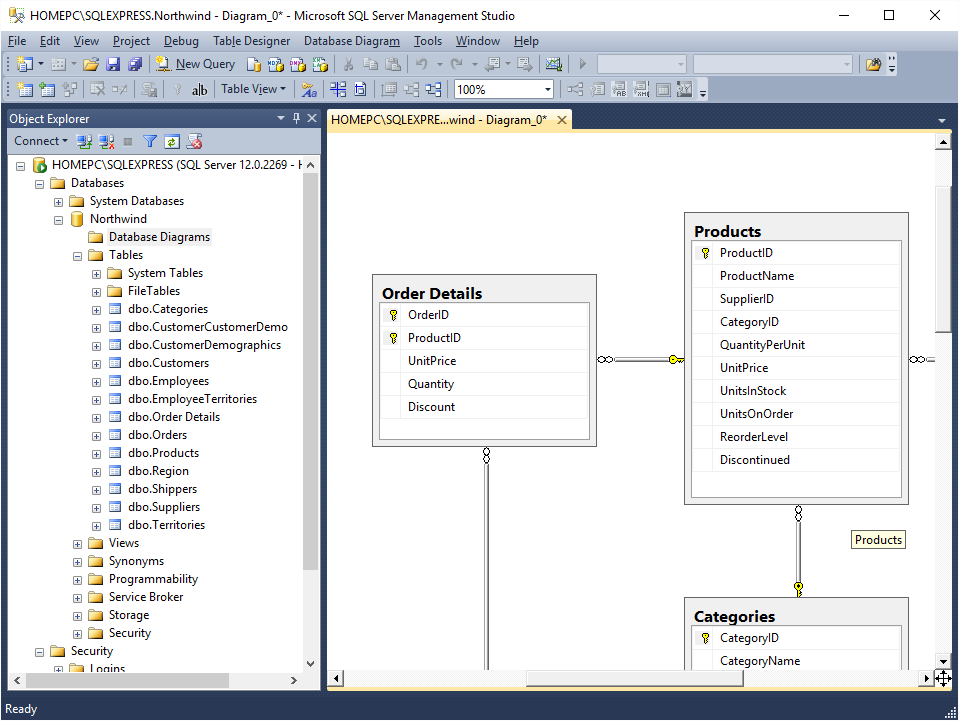- Solutionskeyboard_arrow_down
- Productskeyboard_arrow_down
- Resourceskeyboard_arrow_down
Select theme:
- Material 3
- Material 3 Dark
- Fluent
- Fluent Dark
- Material
- Material Dark
- Standard
- Standard Dark
- Default
- Dark
- Humanistic
- Humanistic Dark
- Software
- Software Dark
End of Year Promotion: Save $100 with code CHEERS2026 — valid until January 10, 2026. See Pricing
Entity Framework Core relationships
I’ve spent last few days working on code generation for cascade delete support in Radzen and found several important facts about Entity Framework Core that might help you in case you work on something similar.
Entity Framework Core will create automatically one-to-many relationships if you have just navigation property and Key attribute:
 Northwind Database Diagram — Customers -> Orders
Northwind Database Diagram — Customers -> Orders
public class Customer
{
[Key]
public string CustomerID { get; set; }
public ICollection<Order> Orders { get; set; }
}
public class Order
{
[Key]
public int OrderID { get; set; }
public string CustomerID { get; set; }
}
If you have composite primary key you cannot use only the Key attribute to define composite keys:
 Northwind Database Diagram — Order Details
Northwind Database Diagram — Order Details
public class OrderDetail
{
[Key]
public int OrderID { get; set; }
[Key]
public int ProductID { get; set; }
}
This can be done via the Fluent API in your DbContext class OnModelCreating override:
public class NorthwindContext : DbContext
{
public NorthwindContext(DbContextOptions<NorthwindContext> options):base(options) { }
public NorthwindContext() { }
protected override void OnModelCreating(ModelBuilder builder)
{
builder.Entity<OrderDetail>().HasKey(table => new {
table.OrderID, table.ProductID
});
}
public DbSet<Customer> Customers { get; set; }
public DbSet<Order> Orders { get; set; }
public DbSet<OrderDetail> OrderDetails { get; set; }
}
If you want to delete principal/parent entity you need to include dependent/child entities:
public void DeleteCustomer(string key)
{
using (var db = new NorthwindContext())
{
var customer = this.context.Customers
.Where(i => i.CustomerID == key)
.Include(i => i.Orders)
.SingleOrDefault();
if (item != null)
{
db.Remove(customer);
db.SaveChanges();
}
}
}
More info about EF Core cascade delete can be found here: https://docs.microsoft.com/en-us/ef/core/saving/cascade-delete
Enjoy!
What We Shipped in 2025 (So Far)
October Update: GitHub Copilot, PivotDataGrid, and more new tools to boost your Blazor development
New: RadzenSkeleton Blazor Component
Add AI Chat to Your Blazor Apps with RadzenAIChat
We Rebuilt Our Website with Blazor – Here's Why (and How)
New App Template: Real Estate Website
Radzen Blazor Components v7.0 released!
Solutions
Products
Recognition
Get started today
Radzen is free to use. You can also test the premium features for 15 days.
Start FreeDesigned and developed with ❤️ in Radzen Blazor Studio.
Select theme:
- Material 3
- Material 3 Dark
- Fluent
- Fluent Dark
- Material
- Material Dark
- Standard
- Standard Dark
- Default
- Dark
- Humanistic
- Humanistic Dark
- Software
- Software Dark